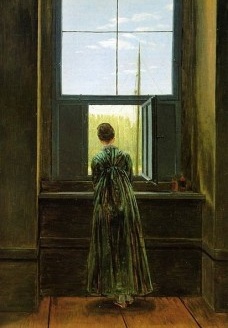
newspaper
agenda cultural
During the Romantic era, the open window appeared either as the sole subject or the main feature in many pictures of interiors that were filled with a poetic play of light and perceptible silence. Rooms with a View: The Open Window in the 19th Century, at The Metropolitan Museum of Art from April 5, through July 4, 2011, is the first exhibition to focus on this motif as captured by German, Danish, French, and Russian artists around 1810-1820. It will feature 31 oil paintings and 26 works on paper, and will consist mostly of generous loans from museums in Germany, Denmark, France, Austria, Switzerland, and the United States.
The exhibition is made possible by the Anna-Maria and Stephen Kellen Foundation and the Isaacson-Draper Foundation.
In 1805–1806, the important German Romantic artist Caspar David Friedrich (1775–1840) created two sepia drawings of the views outside the window of his studio in Dresden that became greatly influential. In Friedrich's treatment of the open window, the Romantics recognized a potent symbol for the threshold experience of being caught between the interior and the outside world. The motif's juxtaposition of the very close and the far away became a metaphor for unfulfilled longing, a sentiment first expressed by the Romantic poet Novalis (Friedrich von Hardenberg, 1772-1802), who wrote: "Everything at a distance turns into poetry: distant mountains, distant people, distant events: all becomes Romantic." Like Friedrich, other Romantic artists were drawn to the view from the window for its symbolic power, and not simply for the beauty of the landscape itself. For them, the rectangular or square shape of the canvas echoed perfectly the window as a view of the world.
Rooms with a View will feature the two seminal Friedrich images—to be shown for the first time in this country—as well as works by the many artists of the period who were influenced by him, including Carl Gustav Carus, Johan Christian Dahl, Georg Friedrich Kersting, Adolph Menzel, and Léon Cogniet, among others. The works will be shown in distinct groupings: austere hushed rooms with contemplative figures reading, sewing, or writing; studios with artists at work; and windows as sole motif. The intangible mood in these pictures is ineffable and can shift between early Romantic severity and Biedermeier coziness.
Rooms with a View is organized by Sabine Rewald, Jacques and Natasha Gelman Curator in the Department of Nineteenth-Century, Modern, and Contemporary Art at the Metropolitan Museum.
The exhibition will be accompanied by a catalogue written by Sabine Rewald and published by The Metropolitan Museum of Art. It will be on sale in the Museum's book shops.
The catalogue is made possible by the Anna-Maria and Stephen Kellen Foundation.
An audio tour, part of the Museum's Audio Guide Program, will be available for rental ($7, $6 for Members, $5 for children under 12).
The Audio Guide is sponsored by Bloomberg.
A variety of educational programs accompany the exhibition including gallery talks, Drop-in Drawing sessions, and a Sunday at the Met lecture program followed by a musical presentation on May 22.

Caspar David Friedrich (German, 1774–1840). Woman at the Window, 1822. Staatliche Museen zu Berlin, Alte Nationalgalerie.

